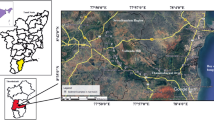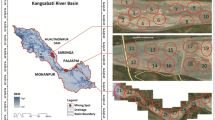Abstract
The shifting of the Ganga has been a long-term phenomenon that has constantly shaped and reshaped the territorial history of Malda district. The present study deals with the analysis of particle size distribution of the bank in Manikchak Diara and assessment of river bank stability by analyzing the particle size distribution of the bank soil, using soil sieving, assessing the river bank stability on the basis of estimated value of Uniformity Coefficient, Coefficient of Gradation and Sorting Coefficient and developing particle size distribution curves and assessment of the bank stability in Manikchak Diara of Malda District, West Bengal. The soil texture along the river bank of Manikchak Diara is attributed by fine to very fine sands which promotes favourable condition of the entrainment of particles from the river bank stratigraphy and induces tensional cracks and finally causes land loss through bank erosion. Most of the soil sample analysis depicted low uniformity co-efficient, sorting co-efficient and gradation co-efficient values which denotes uniform size of the particles available along the river bank of Manikchak Diara. Such uniform size of the particles mean more pore spaces in the soil which also helps easy percolation and easy horizontal sub-surface flow water. The whole situation introduces river bank weakening process in the region. The physical properties of soil in Manikchak Diara plays an important role in reducing soil cohesion and strength properties and invites favourable condition for bank erosion and land loss.









Similar content being viewed by others
References
Amiri Tokaldany E, Darby SE, Tsswell P (2003) Bank stability analysis for predicting reach scale land loss and sediment yield. J Am Water Resour Assoc 39(4):897–909. https://doi.org/10.1111/j.1752-1688.2003.tb04414.x
Arohunsoro SJ (2011) Spatial Analysis of Geomorphological Problems in River Analysis Drainage Basin in Ado-Ekiti, Nigeria. A Ph.D Thesis Department of Geography and Planning Science, University of Ado-Ekiti, Nigeria. (Unpublished)
Barker R, Dixon L, Hooke J (1997) Use of terrestrial photogrammetry for monitoring and measuring bank erosion. Earth Surf Proc Land 22:1217–1227. https://doi.org/10.1002/(SICI)1096-9837(199724)22:13%3C1217::AID-SP819%3E3.0.CO;2-U
Bo NI, Wu SQ, Tan YF, Xie XH, Jun YA, Yan ZM, Geng YQ (2011) Coupling effect of seepage flow and river flow on bank failure. J Hydrodyn 23:834–840
Briaud JL (2008) Case histories in soil and rock erosion: Woodrow Wilson Bridge, Brazos River Meander, Normandy Cliffs, and New Orleans Levees. J Geotech Geoinviron Eng ASCE 134:1424–1447
Briaud JL, Ting F, Chen HC, Cao Y, Han SW, Kwak KW (2001) Erosion function apparatus for scour rate predictions. J Geotech Geoenviron Eng ASCE 127:105–113
Briaud JL, Chen HC, Li Y, Nurtjahyo P, Wang J (2004) SRICOS-EFA method for complex piers in fine-grained soils. J Geotech Geoenviron Eng ASCE 130:1180–1191
Bull LJ (1997) Magnitude and variation in the contribution of bank erosion to the suspended sediment load of the River Severn, UK. Earth Surf Proc Land 22:1109–1123. https://doi.org/10.1002/(SICI)1096-9837(199712)22:12%3c1109::AID-ESP810%3e3.0.CO;2-O
Cancienne RM, Fox GA, Simon A (2008) Influence of seepage undercutting on the stability of root-reinforced streambanks. Earth Surf Process Landf 33:1769–1786
Casagli N, Rinaldi M, Gargini A, Curini A (1990) Pore water pressure and streambank stability: results from a monitoring site on the Seive River, Italy. Earth Surf Process Landf 24:1095–1114
Census of India (2001) Provisional population totals, West Bengal, Table 4. Maldah District (06). Government of West Bengal. http://web.cmc.net.in/wbcensus/DataTables/02/Table4_6.htm. Accessed 21 Jul 2018
Charlton R (2008) Fundamentals of Fluvialgeomorphology
Chen CH, Hsieh TY, Yang JC (2017) Investigating effect of water level variation and surface tension crack on riverbank stability. J Hydro-Environ Res 15:41–53
Chu-Agor ML, Fox GA, Cancienne RM, Wilson GV (2008) Seepage caused tension failures and erosion undercutting of hill slopes. J Hydrol 359:247–259
Chu-Agor ML, Fox GA, Wilson GV (2009) Empirical sediment transport function predicting seepage erosion undercutting for cohesive bank failure prediction. J Hydrol 377:155–164
Dapporto S, Rinaldi M, Casagli N (2001) Failure mechanisms and pore pressure condition analysis of Riverbank along the Arno River (Central Italy). Eng Geol 61:221–242
Darby SE, Rinaldi M, Dapporto S (2007) Coupling simulations of fluvial erosion and mass wasting for cohesive river banks. J Geophys Res 112:1–15
Darby SE, Thorne CR (1996) Numerical simulation of widening and bed deformation of straight sand-bed rivers. II: model evaluation. ASCE J Hydraulic Eng 122(4):194–202. https://www.sciencebase.gov/catalog/item/50538fabe4b097cd4fce4052. Accessed 11 Jan 2022
Duong TT (2014) Assessment of riverbank stability—the perspectives of unsaturated soils and erosion function. Ph.D. Thesis, Ibaraki University, Mito, Japan
Duong TT, Komine H, Do MD, Murakami S (2014) Riverbank stability assessment under flooding conditions in the Red River of Hanoi, Vietnam. Comput Geotech 61:178–189
Eaton BC, Millar RG (2004) Optimal alluvial channel width under a bank stability constraint. Geomorphology 62:35–45. https://doi.org/10.1016/j.geomorph.2004.02.003
Fox GA, Wilson GV, Periketi RK, Cullum RF (2006) Sediment transport model for seepage erosion of streambank sediment. J Hydrol Eng 11:603–611
Fox GA, Wilson GV, Simon A, Langendoen EJ, Akay O, Fuchs JW (2007) Measuring streambank erosion due to ground water seepage: correlation to bank pore water pressure, precipitation and stream stage. Earth Surf Process Landf 32:1558–1573
Fox GA, Heeren DM, Wilson GV, Langendoen EJ, Fox AK, Chu-Agor ML (2010) Numerically predicting seepage gradient forces and erosion: sensitivity to soil hydraulic properties. J Hydrol 389:354–362
GEO-SLOPE International Ltd. (2019a) Seepage Modeling with SEEP/W. http://www.geo-slope.com. Accessed 9 Dec 2019a
GEO-SLOPE International Ltd. (2019b) Stability Modeling with SLOPE/W. http://www.geo-slope.com. Accessed 9 Dec 2019b
Goel J, Kadirvelu K, Rajagopal C, Garg VK (2005) Removal of lead (II) by adsorption using treated granular activated carbon: batch and column studies. J Hazard Mater B125:211–220
Hooke JM (1980) Magnitude and distribution of rates of river bank erosion. Earth Surf Proc Landf 5:143–157. https://doi.org/10.1002/esp.3760050205
Hui L (2015) Yangtze riverbank slope stability by water level change in the three gorges reservoir. Electron J Geotech Eng 20:1847–1856
Keshar et al (1996) Report of Experts’ Committee for Bank Erosion Problem of River Ganga-Padma in the District of Malda and Murshidabad. Planning Commission Govt. of India, pp 1–71
Kotoky P, Bezbaruah D, Baruah J, Sarma JN (2005) Nature of bank erosion along the Brahmaputra River channel, Assam, India. Cur Sci 88(4):634–640
Langendoen EJ (2000) Concepts: Conservational Channel Evolution and Pollutant Transport System Software Manual; Research Report No. 16; USDA-ARS National Sedimentation: Oxford, MS, USA
Liang C, Jaksa M, Ostendorf B, Kuo Y (2015) Influence of river level fluctuations and climate on riverbank stability. Comput Geotech 63:83–98
Luppi L, Rinaldi M, Teruggi LB, Darby SE, Nardi L (2008) Monitoring and numerical model of river-bank erosion processes: a case study along the Cecina River (central Italy). Earth Surf Process Landf 34:530–546
Masoodi A, Majdzadeh Tabatabai M, Noorzad A, Samadi A (2017) Effects of soil physico-chemical properties on stream bank erosion induced by seepage in northeastern. Iran Hydrol Sci J 62:2597–2613
Masoodi A, Noorzad A, Majdzadeh Tabatabai MR, Samadi A (2018) Application of short-range photogrammetry for monitoring seepage erosion of riverbank by laboratory experiments. J Hydrol 558:380–391
Millar RG (2000) Influence of bank vegetation on alluvial channel patterns. Water Resour Res 36(4):1109–1118. https://doi.org/10.1029/1999WR900346
Milton EJ, Gilvear DJ, Hooper ID (1995) Investigating change in fluvial systems using remotely sensed data. In: Gurnell A, Petts G (eds) Changing river channels. Wiley, New York, pp 276–301
Mukhopadhyay S (2003) The measurement of river bank erosion and lateral channel change: a review. Earth Surf Proc Landf 18:777–821
Patsinghasanee S, Kimura I, Shimizu Y (2015a) Experimental and numerical study on overhanging failure of river bank. J Jpn Soc Civ Eng Ser B1 Hydraul Eng 71:127–132
Patsinghasanee S, Kimura I, Shimizu Y, Nabi M, Chub-Uppakarn T (2017) Coupled studies of fluvial erosion and cantilever failure for cohesive riverbanks: case studies in the experimental flumes and U-Tapao River. J Hydro-Environ Res 16:13–26
Patsinghasanee S, Kimura I, Shimizu Y, Nabi M (2018) Experiments and modelling of cantilever failures for cohesive riverbanks. J Hydraul Res 56:76–95
Patsinghasanee S, Kimura I, Shimizu Y, Nabi M (2015b) Cantilever failure investigations for cohesive riverbanks. In: Proceedings of the institution of civil engineers-water management, Vol 2. Thomas Telford Ltd, London, pp. 93–108
Rinaldi M, Casagli N, Dapporto S, Gargini A (2004) Monitoring and modeling of pore water pressure changes and river-bank stability during flow events. Earth Surf Process Landf 29:237–254
Rinaldi M, Mengoni B, Luppi L, Darby SE (2008) Mosselman, E. Numerical simulation of hydrodynamics and bank erosion in a river bend. Water Resour Res 44:1–17
Samadi A, Davoudi MH, Amiri Tokaldany E (2011) Experimental study of cantilever failure in the upper part of cohesive riverbanks. Res J Environ Sci 5:444–460
Samadi A, Amiri Tokaldany E, Davoudi MH, Darby SE (2013) Experimental and numerical investigation of the stability of overhanging riverbanks. Geomorphology 184:1–19
Saraiya M, Berkowitz Z, Yabroff KR et al (2010) Cervical cancer screening with both human papillomavirus and Papanicolaou testing vs Papanicolaou testing alone: what screening intervals are physicians recommending? Arch Intern Med 170:977–985
Saynor MJ, Erskine WD, Smith BL, Evans KG (2003) Bed-material grain size changes in the Swift Creek (Ngarradj) catchment between 1998 and 2001. Internal Report 392, Supervising Scientist, Darwin. Unpublished paper
Simon A, Collison AJC (2002) Quantifying the mechanical and hydrological effects of riparian vegetation on stream-bank stability. Earth Surf Process Landf 27:527–546
Simon A et al (1995) Channel adjustment of an unstable coarse-grained alluvial stream: opposing trends of boundary and critical shear stress. Earth Surf Proc Land 21:155–180
Simon A, Curini A, Darby S, Langendoen E (1999) Stream-bank mechanics and the role of bank and near bank processes in incised channels. In: Darby S, Simon A (eds) Incised river channels. John Wiley and Sons, New York, pp 123–152
Simon A, Curini A, Darby SE, Langendoen EJ (2000) Bank and near-bank processes in an incised channel. Geomorphology 35:193–217
Simon A, Pollen N, Langendoen EJ (2006) Influence of two woody riparian species on critical conditions for streambank stability: Upper Truckee River, California. J Am Water Resour Assoc 42:99–113
Walker H, Brammer S (2009) Sustainable procurement in the UK public sector. Supply Chain Manag Int J 14(2):127–138
Watson A, Basher L (2006) Stream bank erosion: a review of processes of bank failure, measurement and assessment techniques, and modelling approaches. A report prepared for stakeholders of the Motueka integrated catchment management programme and the raglan fine sediment study. Landcare Research, Hamilton
Yong GL, Robert E, Thomas YO, Simon A, Blair P, Greimann KW (2014) Modeling of multilayer cohesive bank erosion with a coupled bank stability and mobile-bed mode. Geomorphology 243:116–129
Yu MH, Wei HY, Wu SB (2015) Experimental study on the bank erosion and interaction with near-bank bed evolution due to fluvial hydraulic force. Int J Sediment Res 30:81–89
Author information
Authors and Affiliations
Corresponding author
Additional information
Publisher's Note
Springer Nature remains neutral with regard to jurisdictional claims in published maps and institutional affiliations.
Rights and permissions
About this article
Cite this article
Majumdar, S., Mandal, S. Assessment of geotechnical properties of the bank sediment to investigate the riverbank’s stability along the Ganga river within the stretch of Malda district, West Bengal, India. Sustain. Water Resour. Manag. 8, 44 (2022). https://doi.org/10.1007/s40899-022-00637-w
Received:
Accepted:
Published:
DOI: https://doi.org/10.1007/s40899-022-00637-w




